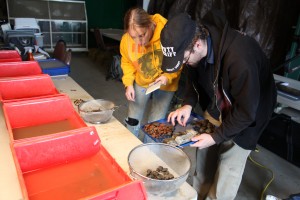Lab Procedures
The systematic collection and control of any and all data collected in the field is the prime imperative of an established field laboratory. The first data control specific task is to identify and label each bucket of soil recovered from the excavation unit with a Unit Number, Level Number, Objective (cm), Date, and ALL Excavators Initials. Do this by noting this information on a length of survey flagging tape using a black permanent marker. The annotated flag should be tied to the bucket handle.
All materials and specimens recovered from the dry screen should be placed on a tray. The tray in question should be clearly marked or flagged with an identification card noting the relevant information, including: Site designation (CA-MNT-233H), Unit Number, Level Number, Objective, Excavators and Recorder’s initials, and Date.
Processing of Specimens
The first procedure required for processing field specimens is to soak and delicately clean them with a non-abrasive brush and water. First, you should prepare a tray with a layer of paper towels to absorb the water from the soaked specimens. The tray should be clearly identified with any and all relevant field unit information, including: Site Designation (CA-MNT-233H), Unit Number, Level Number, Objective, Excavators and Recorder’s initials (if not the same) and Date. The soaking and cleaning of specimens should be completed within a bucket that has in turn been clearly marked with field information as noted.
A toothbrush will be used to gently remove soils and clays from the surface of each specimen so treated. Do not scrub materials too harshly! For specimens such as tile, or foundation stone, a larger brush may be used. Permit specimens to properly dry before bagging and tagging. You may conduct a preliminary sort of the processed specimens into material types, if identifiable, at this time. Please permit adequate time for materials so processed to completely dry before bagging and tagging.
Catalogue Entry
1. Hand process and sort with tweezers or other suitable tool all specimens processed. Material types include, but are not limited to: Shell, Lithics, Glass, Metal, Ceramics, Tile, Siltstone, Wood, Bone, Charcoal, etc. Distinct specimens, particularly those modified apart from their material type, such as burnt bone, should be separated from the broader material type or group.
2. For quality assurance, please have someone other than you check your sorting and identification of specimens or material types.
3. Please complete the catalog card, taking into account the quantities and weights prior to bagging by material type or Lot. Each material type will receive its own bag and catalog card. Make use of those catalog cards that have been pre-numbered with a stamped catalog number! Each specimen’s bag will receive its own individualized Catalog and Field Specimen Number. Please assure that the catalog card is fully completed! The Catalog Card should be placed within the plastic bag along with those specimens documented therein.
4. Upon completion of the Catalog Card and unit level specimens processing, please enter relevant information into the Field Specimens Catalog as well. It is imperative that all completed specimen’s bags and Catalog Cards be recorded within the Field Specimens Catalog. Information recorded in the Field Specimen’s Catalog is as follows: Site Number, Excavator(s), Recorder(s), Date, Feature, Unit Number, Level Number, Objective, Catalog and Field Specimens Number, Description, Material Type, and Weight. Upon completion of the unit level, please begin a new Field Specimens Catalog page. You should use one Field Specimens Catalog sheet per unit level. Do not attempt to complete a Field Specimens Catalog sheet for each individual date during which said unit was under excavation. One Field Specimens Catalog sheet per unit level is all that is required. Each new date during which the unit level is under excavation must be recorded if completion of a level takes more than a single day.
5. Once any and all relevant information has been recorded in the Field Specimens Catalog, it must then be entered into the Wireless Site Catalog Tool available here, or made available on-site with a Microsoft Excel database substitute data entry catalog. You are to fully document any and all relevant unit level and specimen information on an ongoing basis.
Adapted from a document prepared by Michelle St. Clair and substantially revised and edited by and for Ruben G. Mendoza, Ph.D., Principal
Investigator/Project Archaeologist, CSUMB, February 14, 2003.


